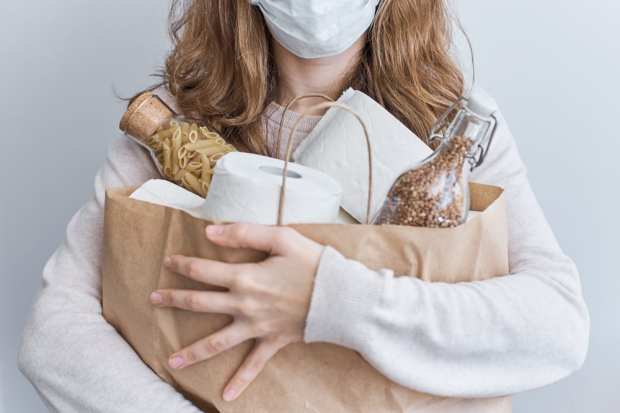The 10 Ways COVID-19 Has Changed The American Consumer

For the last several weeks normal life in the United States and around the world has been on hold in a way that has never been seen before — and that no one could have predicted. As the coronavirus pandemic continues, day-to-day life has changed for nearly everyone down to what were once the simplest, most straightforward and least considered parts of daily living. Going to work, grabbing groceries and keep household supplies of toilet paper were things most people rarely stopped to consider a month ago, but these days take a heretofore unprecedented amount of planning and logistical support.
And as the world has changed, it should come as no surprise that consumers have changed to adapt to it — in ways big and small. We at PYMNTS know this because we’ve bee surveying consumers by thousands through every week of the crisis as it unfolds to understand how they’re feeling, what they’re doing and what their likely next moves will be. What the latest edition of the data makes clear above all is that the consumers who went into quarantine in mid-March may well behave very differently when they emerge from social distancing over the next several months. Assuming, as Karen Webster points out in her commentary on the new data, that they are all that enthusiastic to emerge at all.
“Consumers will shift spend to the places where they feel comfortable transacting — which is now, and will be for some time, online, and physically distant from what they perceive to be the personal risks associated with reentering the physical world to conduct business or engage in commerce,” Webster wrote.
And while it is still too early to know what the long-term picture will be, the data we have already highlights the top 10 ways consumers have become slightly different people over the last several weeks.
10. From Digital First to Digital Only
Digital-first consumers have become digital-only consumers who are now nearly entirely online to shop, bank, work, work out, worship, eat, entertain themselves and their families, stay connected socially and tap into healthcare services. Some of that is necessity — stay-at-home orders have shut down physical commerce everywhere. But given the uptick in digital shopping like grocery (despite stores remaining open) indicates that some of the switch isn’t necessity, but choice.
9. A Nation of Home Cooks …
While restaurant interaction has converted to digital, interaction has steeply dropped off as people are taking all those groceries they loaded up on and have started learning to actually cook meals. According to PYMNTS data, 93 percent of customers report eating at restaurants less.
8. … and Emerging Puzzle Enthusiasts
What are Americans doing to entertain themselves? Many of the answers can probably guessed — streaming movies, video chatting and playing videos are all solid answers. But consumers have discovered a deep and abiding love of such low-tech thrills as puzzles and board games. Consumers are also four times more likely to buy games and puzzles (35 percent) than sporting goods (9.5 percent) as they fight the war on boredom.
7. A New Penchant for Belt-Tightening
Consumers at all income levels, it seems, are becoming better savers as they attempt to keep more cash on hand as the crisis wears on. On March 28, 41 percent of consumers reported they did not live paycheck to paycheck — only 10 days prior, 34 percent of consumers reported the same. And the average income of those no longer living paycheck to paycheck has fallen, from $98.8K to $91.1K in the last 10 days, suggesting that even those who can pay their bills are still conserving their cash.
6. Navigating Growing Uncertainty
As the crisis goes on longer, so do its economic impacts on consumers. As of March 28, 55 percent of Americans reported having two weeks or less worth of cash available to pay the bills before dipping into savings — a seven-fold jump from the 8 percent just 22 days earlier on March 6.
5. Increasingly Pessimistic About the Financial Future …
Over the last 22 days, 15 percent of consumers have reported no longer having a job, and among those who still do optimism is not high. Today, some 47 percent of the workers we polled report being concerned about losing their jobs, while 28 percent of the workforce — 45 million consumers — report being extremely concerned about losing their jobs.
4. More Health-Conscious
When polled a few weeks ago, only about a third of consumers reported serious concerns about COVID-19. That has nearly completely reversed — two thirds (66 percent) of Americans report being very or extremely concerned about contracting the coronavirus. The data also showed a 3.4 percent spike in the percentage of Americans who fear dying from the coronavirus and a corresponding decrease of 6.6 percent in their concern of spreading it to family and friends.
3. Sticking to the Necessities
While shopping is down across the board — 87 percent of consumers report shopping less for groceries, and 80 percent are shopping less for things that aren’t groceries, according to PYMNTS data — they are still shopping, though now with much different focus. Three times more consumers are buying cleaning supplies (59 percent) than clothes (19 percent) and four times more consumers are buying medical supplies (43 percent) than home furnishings (11 percent).
2. … and More Willing to Try New (Digital) Things
And those consumers are willing to try new things online — in healthcare and grocery most notably since they’d been the great holdouts in the digitization of commerce. The percentage of consumers who shop online for groceries tripled – from 3 percent on March 6 to 9 percent on March 28 — while the share of consumers who shop online for things other than groceries more than doubled, from 13 percent to 30 percent.
1. They Just Might Be Staying in Longer Than Expected
When can we expect the arrival of normal into our day-to-day lives again? That could be longer than expected, as all of the above combined into creating consumers who are worried about their financial future, are economically challenged and have spent the last several weeks relocating their lives online. And according to the data, the one thing most likely to get them feeling safe and comfortable in public again is a vaccine against COVID-19. Seventy-one percent of consumers report that is the key — more than flattening the curve (66 percent) or having therapeutic treatments available (63 percent).
Given that the most optimistic estimates for a vaccine still put it over a year away? That likely means that while normal will eventually return, what it looks like and how consumers act within it might not much look much like the normal they left behind at the outset of the coronavirus crisis.
